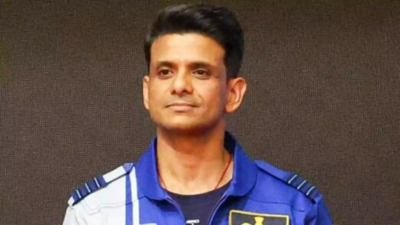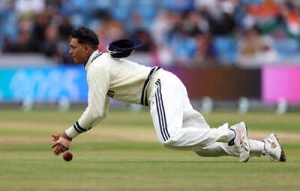The Axiom-4 mission, carrying Shubhanshu Shukla and three other astronauts, launched on Wednesday at 12:01 pm IST from NASA's Kennedy Space Center, embarking on a journey to the International Space Station (ISS). The crew, consisting of Shukla, Anne McClain, Nichole Ayers, and Peggy Whitson, will spend approximately two weeks at the orbiting laboratory conducting scientific research. Docking is scheduled for 4:30 pm IST on Thursday at the space-facing port of the Harmony module.

India celebrates the launch of Shubhanshu Shukla on the Axiom-4 mission.
This timeline indicates a roughly 28.5 to 29-hour journey from launch to docking. Once aboard the ISS, the crew will dedicate their time to various scientific investigations and outreach initiatives.
The launch originated from Launch Complex 39A at NASA's Kennedy Space Center in Florida, a location steeped in history as the departure point for Neil Armstrong's lunar mission. Donning specialized flight suits, the Ax-4 crew boarded the Dragon capsule "C213". Pre-launch procedures were meticulously executed in collaboration with SpaceX and NASA teams.
Approximately 35 minutes before launch, the Launch Director authorized fueling after activating the crew's emergency escape system. The Falcon-9 rocket was then loaded with supercooled liquid oxygen and RP-1 kerosene fuel. With five minutes remaining, the Dragon capsule switched to internal power, requiring perfect synchronization of all systems at the culmination of the countdown.
At T-0, the nine Merlin engines of Falcon-9 ignited, propelling the spacecraft skyward. Within one minute, the vehicle surpassed the speed of sound. The "Max Q" phase, characterized by peak aerodynamic stress on the vehicle, occurred at 57 seconds.
The spacecraft maintained its precise trajectory towards low-Earth orbit (LEO), during which the crew experienced increasing gravitational forces.
Approximately 150 seconds after launch, the first stage detached and initiated its return to Earth, targeting an automated landing on a platform in the Atlantic Ocean. Meanwhile, the second stage continued to propel the Dragon capsule towards its intended orbit.
Ten minutes after launch, Dragon separated and began its independent flight, revealing essential navigation equipment. The spacecraft reached speeds exceeding 27,000 km/hr, completing an orbit of Earth every 90 minutes.
The subsequent 20-24 hours involved carefully orchestrated orbital adjustments. Dragon executed precise engine burns to align its trajectory with that of the ISS. The spacecraft relied on GPS, radar, and internal sensors for accurate positioning.
Dragon approached the ISS systematically, pausing at designated waypoints, starting from 400 meters out. Ground control authorized each stage of the approach. At 20 meters, the spacecraft's laser sensors and cameras guided it toward the Harmony module's docking port.
The connection occurred in two phases: magnetic soft capture, followed by mechanical hard capture, which created an airtight seal between the spacecraft and the ISS.
Following thorough pressure and leak checks, the crew entered the ISS. The Ax-4 team then initiated their two-week scientific program, which includes research into diabetes. For Shubhanshu Shukla, this mission represents a personal milestone and underscores India's growing presence in space exploration.
Newer articles
Older articles
 Chess Star Praggnanandhaa Weighs In on Carlsen's Frustration After Loss to Gukesh
Chess Star Praggnanandhaa Weighs In on Carlsen's Frustration After Loss to Gukesh
 Samsung Galaxy A35 5G and A55 5G: Official Pricing and Availability Announced
Samsung Galaxy A35 5G and A55 5G: Official Pricing and Availability Announced
 India's Fielding Woes Blamed for First Test Defeat Against England: Former Selector Voices Concerns
India's Fielding Woes Blamed for First Test Defeat Against England: Former Selector Voices Concerns
 Headline: Viral Optical Illusion: Can You Find All the Hidden Animals? Only 1% Succeed
Headline: Viral Optical Illusion: Can You Find All the Hidden Animals? Only 1% Succeed
 Shadman Stands By Bangladesh Batters After Day 1 Struggles Against Sri Lanka
Shadman Stands By Bangladesh Batters After Day 1 Struggles Against Sri Lanka
 Norris Claims Thrilling Austrian GP Victory After Intense Duel with McLaren Teammate Piastri
Norris Claims Thrilling Austrian GP Victory After Intense Duel with McLaren Teammate Piastri
 Jake Paul's Title Dreams: Analyzing Championship Prospects and Potential Opponents
Jake Paul's Title Dreams: Analyzing Championship Prospects and Potential Opponents
 Gavaskar Urges India to Unleash Kuldeep Yadav in Second Test Amid Bumrah Fitness Concerns
Gavaskar Urges India to Unleash Kuldeep Yadav in Second Test Amid Bumrah Fitness Concerns
 iQoo Z9 Turbo Leaks: Snapdragon 8s Gen 3, 1.5K Display, and Massive Battery Detailed
iQoo Z9 Turbo Leaks: Snapdragon 8s Gen 3, 1.5K Display, and Massive Battery Detailed
 Mirabai Chanu Reveals Relentless Dedication: Training and Weight Always Top of Mind, Even During Family Time
Mirabai Chanu Reveals Relentless Dedication: Training and Weight Always Top of Mind, Even During Family Time